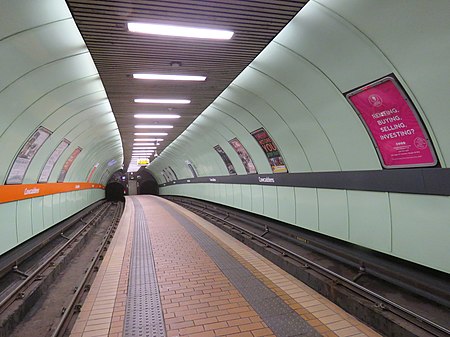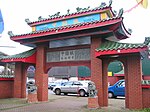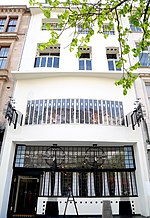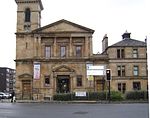Cowcaddens (Scots: Coucaddens, Scottish Gaelic: Coille Challtainn) is an area of the city of Glasgow, Scotland. It is very close to the city centre and is bordered by the newer area of Garnethill to the south-west and old Townhead to the east.
Cowcaddens was originally a village and became an industrious and thriving part of the expanding Glasgow, being close to Port Dundas and the Forth and Clyde Canal immediately to its north. Its boundaries merged into the City of Glasgow in 1846. By the 1880s, the area was becoming a slum district with the highest level of infant mortality (190 per thousand births) in the city, a figure which was three times that of the West End. Like neighbouring Townhead, Cowcaddens was one of many areas in Glasgow declared a Comprehensive Development Area (CDA) by Glasgow Corporation which led to the mass demolition of the tenement slums, and their replacement with a mixture of lower density housing, commercial and educational zones. The construction of the Glasgow Inner Ring Road in the late 1960s brought huge changes to the northern part of Cowcaddens with major realignment of roads and throughfares.
Cowcaddens is served by Cowcaddens subway station on the Glasgow Subway system, and by bus services through it and emanating from Buchanan Bus Station. Glasgow Caledonian University is nearby.The southern fringes of Cowcaddens have historically housed one of Glasgow's premier entertainment districts, with theatres and cinemas dotted throughout the neighbourhood. Notable venues included: the Theatre Royal on Hope Street; The Royalty Theatre on Sauchiehall and Renfield Streets; The Grand Theatre at Cowcaddens Cross; The Scottish Zoo and Hippodrome on New City Road; The Pavilion Theatre on Renfield Street; Green's Playhouse, later the Apollo music hall on Renfrew Street; The Glasgow Film Theatre on Rose Street; The STV headquarters, built in 1974 on Renfield Street. As of 2021, only the Royal, Pavilion, and GFT remain, and the site of the old Apollo is now home to a Cineworld. Since 1988 the Royal Conservatoire of Scotland, formerly RSAMD, has had its main campus on Renfrew Street, with another facility on Garscube Road. The former Cowcaddens Free Church now houses the National Piping Centre.
Housing in the area is primarily ex-council housing (there are no council houses in Glasgow since their transfer to the Glasgow Housing Association).
In 2007 the Cowcaddens pedestrian underpass was decorated with 15 screen prints by artist Ruth Barker.











